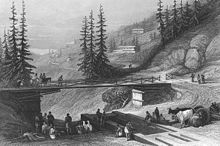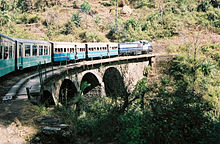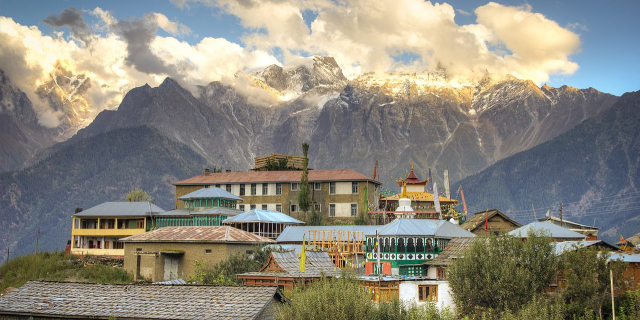Shimla (English: ; Hindi: [ˈʃɪmla] ; also known as Simla, the official name until 1972) is the capital and the largest city of the northern Indian state of Himachal Pradesh. In 1864, Shimla was declared as the summer capital of British India. After independence, the city became the capital of East Punjab and was later made the capital city of Himachal Pradesh. It is the principal commercial, cultural and educational centre of the state.
Small hamlets were recorded before 1815 when British forces took control of the area. The climatic conditions attracted the British to establish the city in the dense forests of the Himalayas. As the summer capital, Shimla hosted many important political meetings including the Simla Deputation of 1906, the Simla Accord of 1914 a...Read more
Shimla (English: ; Hindi: [ˈʃɪmla] ; also known as Simla, the official name until 1972) is the capital and the largest city of the northern Indian state of Himachal Pradesh. In 1864, Shimla was declared as the summer capital of British India. After independence, the city became the capital of East Punjab and was later made the capital city of Himachal Pradesh. It is the principal commercial, cultural and educational centre of the state.
Small hamlets were recorded before 1815 when British forces took control of the area. The climatic conditions attracted the British to establish the city in the dense forests of the Himalayas. As the summer capital, Shimla hosted many important political meetings including the Simla Deputation of 1906, the Simla Accord of 1914 and the Simla Conference of 1945. After independence, the state of Himachal Pradesh came into being in 1948 as a result of the integration of 28 princely states. Even after independence, the city remained an important political centre, hosting the Simla Agreement of 1972. After the reorganisation of the state of Himachal Pradesh, the existing Mahasu district was named Shimla.
Shimla is home to several buildings that are styled in the Tudorbethan and neo-Gothic architectures dating from the colonial era, as well as multiple temples and churches. The colonial architecture and churches, the temples, and the natural environment of the city attract tourists. Major city centre's attractions include the Shri Hanuman Jakhu (Statue), Jakhu Temple, Viceregal Lodge, Christ Church, Mall Road, The Ridge and Annadale. The city centre's northernmost point is Jakhoo and the southernmost location is Annadale, the easternmost point is Sanjauli and the western point is Chotta Shimla. The Kalka–Shimla Railway line built by the British, a UNESCO World Heritage Site, is also a major tourist attraction. Owing to its steep terrain, Shimla hosts the mountain biking race MTB Himalaya, which started in 2005 and is regarded as the biggest event of its kind in South Asia. Shimla also has the largest natural ice skating rink in South Asia. Apart from being a tourism centre, the city is also an educational hub with several colleges and research institutions.
Most of the area occupied by present-day Shimla city was dense forest during the 18th century. The only sign of civilisation was the Jakhu Temple and a few scattered houses.[1] The area was called 'Shimla', named after a Hindu goddess, Shyamala Devi, an incarnation of Kali.[2]
 The bridge connecting Shimla with Chhota Shimla, originally erected in 1829 by Lord Combermere, Shimla, the 1850s
The bridge connecting Shimla with Chhota Shimla, originally erected in 1829 by Lord Combermere, Shimla, the 1850sThe area of present-day Shimla was invaded and captured by Bhimsen Thapa of Nepal in 1806. The British East India Company took control of the territory as per the Sugauli Treaty after the Anglo-Nepalese War (1814–16). The Gurkha leaders were quelled by storming the fort of Malaun under the command of David Ochterlony in May 1815. In a diary entry dated 30 August 1817, the Gerard brothers, who surveyed the area, describe Shimla as "a middling-sized village where a fakir is situated to give water to the travellers". In 1819, Lieutenant Ross, the Assistant Political Agent in the Hill States, set up a wood cottage in Shimla. Three years later, his successor and the Scottish civil servant Charles Pratt Kennedy built the first pucca house in the area named Kennedy Cottage in 1822, near Annadale, what is now the home for CPWD office. The accounts of the Britain-like climate started attracting several British officers to the area during the hot Indian summers. By 1826, some officers had started spending their entire vacation in Shimla. In 1827, William Amherst, the Governor-General of Bengal, visited Shimla and stayed in the Kennedy House. A year later, Stapleton Cotton, the Commander-in-Chief of the British forces in India, stayed at the same residence. During his stay, a three-mile road and a bridge were constructed near Jakhoo. In 1830, the British acquired the surrounding land from the chiefs of Keonthal and Patiala in exchange for the Rawin pargana and a portion of the Bharauli pargana. The settlement grew rapidly after this, from 30 houses in 1830 to 1,141 houses in 1881.[1][3]
In 1832, Shimla saw its first political meeting between the Governor-General Lord William Bentinck and the emissaries of Maharaja Ranjit Singh. In a letter to Colonel Churchill, he wrote:[4]
Shimla is only four days march from Loodianah (Ludhiana), is easy to access, and proves a very agreeable refuge from the burning plains of Hindoostaun (Hindustan).
 Jakhu Temple in 1910; the temple predates the British settlement in the area
Jakhu Temple in 1910; the temple predates the British settlement in the areaCombermere's successor Earl Dalhousie visited Shimla in the same year. After this, the town was under Nawab (King) Kumar Ghosal of Bally, West Bengal, and saw regular visits from the Governors-General and Commanders-in-Chief of British India. Several young British officers started visiting the area to socialise with the higher-ups; they were followed by ladies looking for marriage alliances for their relatives. Shimla thus became a hill station famous for balls, parties, and other festivities. Subsequently, residential schools for pupils from upper-class families were established nearby. By the late 1830s, the city also became a centre for theatre and art exhibitions. As the population increased, several bungalows were built and a big bazaar was established in the town. The Indian businessmen, mainly from Sood and Parsi communities, arrived in the area to cater to the needs of the growing European population. On 9 September 1844, the foundation of the Christ Church was laid. Subsequently, several roads were widened and the construction of the Hindustan-Tibet road with a 560-feet tunnel was taken up in 1851–52. This tunnel, now known as the Dhalli Tunnel, was started by Major Briggs in 1850 and completed in the winter of 1851–52.[5] The 1857 uprising caused a panic among the European residents of the town, but Shimla remained largely unaffected by the rebellion.[1]
In 1863, the Viceroy of India, John Lawrence, decided to shift the summer capital of the British Raj to Shimla.[1] He took the trouble of moving the administration twice a year between Calcutta and this separate centre over 1,000 miles away, even though it was difficult to reach.[6] Robert Bulwer-Lytton (Viceroy of India 1876–1880) made efforts to plan the town from 1876, when he first stayed in a rented house, but began plans for a Viceregal Lodge, later built on Observatory Hill. A fire cleared much of the area where the native Indian population lived (the "Upper Bazaar" nowadays known as the Ridge[7]), and the planning of the eastern end to become the centre of the European town forced them to live in the Middle and Lower Bazaars on the lower terraces descending the steep slopes from the Ridge. The Upper Bazaar was cleared for a town hall, with many facilities such as a library and theatre, as well as offices for police and military volunteers as well as municipal administration.
 Shimla's "Lower Bazaar" in a photograph taken between 1887 and 1889
Shimla's "Lower Bazaar" in a photograph taken between 1887 and 1889During the "Hot Weather", Shimla was also the headquarters of the Commander-in-Chief, India, the head of the Indian Army, and many departments of the government. The summer capital of the regional Government of the Punjab moved from Murree, in modern-day Pakistan, to Shimla in 1876. They were joined by many of the British wives and daughters of the men who remained on the plains. Together these formed the Shimla Society, which, according to Charles Allen,[8] "was as close as British India ever came to having an upper crust." This may have been helped by the fact that it was very expensive, having an ideal climate and thus being desirable, as well as having limited accommodation. British soldiers, merchants, and civil servants moved here each year to escape from the heat during summer in the Indo-Gangetic plain. The presence of many bachelors and unattached men, as well as the many women passing the hot weather there, gave Shimla a reputation for adultery, and at least gossip about adultery: as Rudyard Kipling said in a letter cited by Allen, it had a reputation for "frivolity, gossip, and intrigue".[9]
The 500-foot (150 m) Lower Bazaar tunnel was built in 1905 and christened Khachhar Surang. The Elysium Tunnel (now known as the Auckland Tunnel), about 120 feet (37 m) in length, was also built in 1905.[5]
The Simla Convention, an ambiguous treaty concerning the status of Tibet negotiated by representatives of the Republic of China, Tibet and Great Britain was signed in Simla in 1913 and 1914.[10][11] At the convention a demarcation line between Tibet and the North-east region of India was proposed by Sir Henry McMahon. The line came to be known as McMahon Line and is currently the effective boundary between China and India, although its legal status is disputed by the Chinese government. This was also the site of a series of talks held by Viceroy Wavell to discuss a plan for the independence of India with the Indian political leaders of the time. Known as the Simla Conference, the talks failed to bring about a resolution.
Shimla was the capital city in exile of British Burma (present-day Myanmar) from 1942 to 1945.[12]
 Passenger train on the Kalka-Shimla Railway route
Passenger train on the Kalka-Shimla Railway routeThe Kalka–Shimla railway line, opened in 1903, added to Shimla's accessibility and popularity. The railway route from Kalka to Shimla, with more than 806 bridges and 103 tunnels, was touted as an engineering feat and came to be known as the "British Jewel of the Orient".[9] In 2008, it became part of the UNESCO World Heritage Site.[13] Following the partition of India, it briefly served as the capital of East Punjab, until construction of the new city of Chandigarh (the present-day capital of the Indian states of Punjab and Haryana). Upon the formation of the state of Himachal Pradesh in 1971, Shimla was named its capital.
After independence, the Chief Commissioner's Province of H.P. came into being on 15 April 1948 as a result of the integration of 28 petty princely states (including feudatory princes and zaildars) in the promontories of the western Himalaya, known in full as the Shimla Hills States and four Punjab southern hill states by the issue of the Himachal Pradesh (Administration) Order, 1948 under Sections 3 and 4 of the Extra-Provincial Jurisdiction Act, 1947 (later renamed as the Foreign Jurisdiction Act, 1947 vide A.O. of 1950). The State of Bilaspur was merged into the Himachal Pradesh on 1 April 1954 by the Himachal Pradesh and Bilaspur (New State) Act, 1954. Himachal became a part C state on 26 January 1950 with the implementation of the Constitution of India and the Lt. Governor was appointed. The legislative assembly was elected in 1952. Himachal Pradesh became a Union Territory on 1 November 1956.[14] Following areas of Punjab State namely Shimla, Kangra, Kulu and Lahul and Spiti Districts, Nalagarh tehsil of Ambala District, Lohara, Amb and Una kanungo circles, some areas of Santokhgarh kanungo circle and some other specified area of Una tehsil of Hoshiarpur District besides some parts of Dhar Kalan Tehsil of Pathankot district; were merged with Himachal Pradesh on 1 November 1966 on the enactment of Punjab Reorganisation Act, 1966 by the Parliament. On 18 December 1970, the State of Himachal Pradesh Act was passed by Parliament and the new state came into being on 25 January 1971. Thus Himachal emerged as the eighteenth state of the Indian Union.[14]
The Simla Agreement treaty was signed in Shimla by Zulfiqar Ali Bhutto, the President of Pakistan, and Indira Gandhi, the Prime Minister of India. The agreement paved the way for diplomatic recognition of Bangladesh by Pakistan. Technically the document was signed at 0040 hours on the night of 3 July; despite this official documents are dated 2 July 1972.[15]
Pre-independence structures still dot Shimla; buildings such as the former Viceregal Lodge, Assembly Chamber, Auckland House, Christ Church, Gorton Castle, Shimla Town Hall and the Gaiety Theatre are reminders of British rule in India.[16][17] The original Peterhoff, another Viceregal residence, burned down in 1981. British Shimla extended about a mile and a half along the ridge between Jakhoo Hill and Prospect Hill. The central spine was the Mall Road, which ran along the length of the Ridge, with a Mall Extension southwards, closed to all carriages except those of the viceroy and his wife.

































Add new comment